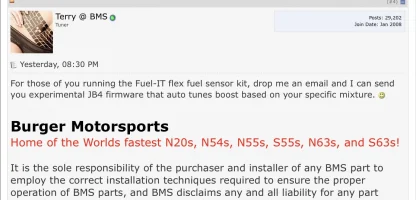Do you do look at the E85 sensor input in the jb4? Or is it purely for logging purposes?
I believe I answered this question previously.
As of July, @Terry@BMS was working on auto tuning for E85. It’s not currently available for the consumer versions of the JB4 firmware for the Stinger platform.
By virtue of the modifications I’ve done, I’ve been running v11 of the JB4 firmware since July 24th.
On 8/3, Terry posted on N54 asking if any owners with the Fuel-It Flex Fuel sensor and access to E85 to drop him an email for experimental values to be entered into the JB4 software to allow for auto tuning.
This was something that was only for those with the Flex Fuel sensor and E85, and not for those, like myself that have WMI and the Flex Fuel sensor, as the auto tuning would’ve been way too conservative for WMI (per the email received from Terry).
Autotuning has been something Terry has been working on, but it hasn’t been rolled out yet and therefore, the answer to your inquiry, is that presently the Flex-Fuel sensor does not allow for auto tuning based on the values it generates — unless you reach out to Terry for the experimental values for the JB4, but it’s not automatically available for everyone. At some point I’d imagine this to change, in particular, with CPI, and perhaps WMI as Terry continues to work on the integration.
Attachments
Last edited:





